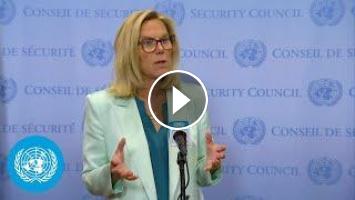Comments to the media by Sigrid Kaag, United Nations Senior Humanitarian and Reconstruction Coordinator for Gaza, following the 9617th meeting of the Security Council on the situation in the Middle East, including the Palestinian question.
Senior Humanitarian and Reconstruction Coordinator for Gaza, Sigrid Kaag announced that the operationalization of the UN 2720 Mechanism for Gaza “will start in the coming days,” adding that she has informed Israel on the operationalization of the Mechanism as per the resolution.
Kaag today (24 Apr) told the Council in New York that the mechanism will initially be applicable to the Cyprus and Jordan routes, respectively. Technical consultations will shortly be finalized with Egypt on its route.
She explained that a database and notification system will go online for all cargo destined for Gaza along supply routes. The approval for the placement of international monitors at crossings, inspection and supply points has been requested from relevant authorities. Verification and monitoring inside Gaza will commence as soon as possible.
In the coming weeks, her office in Gaza will also be operational.
The Senior Humanitarian and Reconstruction Coordinator for Gaza reiterated, “The operationalization of the Mechanism will allow for pipeline prioritization, predictability, visibility and tracking of supplies to Gaza.”
As the Resolution intended, Kaag said, “the Mechanism is designed to facilitate and support the work of all humanitarian partners on the ground.”
With respect to Jordan, she also informed the Council that her team has worked with the concerned authorities to launch the Jordan land corridor under a new streamlined modality.
“This has resulted in an increase in the number of trucks, thereby volume, with only one transloading inside the Gaza crossing, and has the potential for further increases, the senior UN official said, adding that “the entire UN family is planning for the receipt and onward distribution of cargo at scale directly from Jordan to Northern Gaza via the Erez crossing.”
“This route is both effective and vital to reach civilians in Northern Gaza and beyond,” Kaag reiterated.
On the Cyprus maritime corridor, the senior humanitarian official said that it provides for additionality of humanitarian aid to Gaza.
“It can never be a substitute for delivery by land. Land routes are the only way to bring in the bulk of supplies needed,” she highlighted.
Kaag further stated, “Preparations for building the floating port and pier on the shores of Gaza are advancing, with the involvement of the US and other Member States. The UN has outlined the parameters under which it can play a meaningful role in the distribution of aid via this corridor.”
The Senior Humanitarian and Reconstruction Coordinator for Gaza concluded, “Let us remember that behind every statistic is a human story of loss and suffering. It is our duty to provide protection, support and therefore hope to the Palestinian population in Gaza. It is also our duty to advocate for lasting peace between Israel and a fully independent, viable and sovereign Palestinian state.”
After the meeting, Kaag further explained the maritime corridor to reporters.
She said, “you need to leave from Cyprus, the goods will be cleared, the goods will arrive, the humanitarian goods will be cleared, will be security checked, they will be shipped and then there's a pier that's currently pier/port being constructed by the US where the goods will be received, so to speak, and will be received and distributed by the international community across the entire Gaza Strip.”
She added, “For the UN, we have determined a number of parameters under which the UN family is able and in a position to receive and distribute the goods. But there are also a number of international NGOs that are considering participating in the distribution of goods that come via the maritime corridor.”
Senior Humanitarian and Reconstruction Coordinator for Gaza, Sigrid Kaag announced that the operationalization of the UN 2720 Mechanism for Gaza “will start in the coming days,” adding that she has informed Israel on the operationalization of the Mechanism as per the resolution.
Kaag today (24 Apr) told the Council in New York that the mechanism will initially be applicable to the Cyprus and Jordan routes, respectively. Technical consultations will shortly be finalized with Egypt on its route.
She explained that a database and notification system will go online for all cargo destined for Gaza along supply routes. The approval for the placement of international monitors at crossings, inspection and supply points has been requested from relevant authorities. Verification and monitoring inside Gaza will commence as soon as possible.
In the coming weeks, her office in Gaza will also be operational.
The Senior Humanitarian and Reconstruction Coordinator for Gaza reiterated, “The operationalization of the Mechanism will allow for pipeline prioritization, predictability, visibility and tracking of supplies to Gaza.”
As the Resolution intended, Kaag said, “the Mechanism is designed to facilitate and support the work of all humanitarian partners on the ground.”
With respect to Jordan, she also informed the Council that her team has worked with the concerned authorities to launch the Jordan land corridor under a new streamlined modality.
“This has resulted in an increase in the number of trucks, thereby volume, with only one transloading inside the Gaza crossing, and has the potential for further increases, the senior UN official said, adding that “the entire UN family is planning for the receipt and onward distribution of cargo at scale directly from Jordan to Northern Gaza via the Erez crossing.”
“This route is both effective and vital to reach civilians in Northern Gaza and beyond,” Kaag reiterated.
On the Cyprus maritime corridor, the senior humanitarian official said that it provides for additionality of humanitarian aid to Gaza.
“It can never be a substitute for delivery by land. Land routes are the only way to bring in the bulk of supplies needed,” she highlighted.
Kaag further stated, “Preparations for building the floating port and pier on the shores of Gaza are advancing, with the involvement of the US and other Member States. The UN has outlined the parameters under which it can play a meaningful role in the distribution of aid via this corridor.”
The Senior Humanitarian and Reconstruction Coordinator for Gaza concluded, “Let us remember that behind every statistic is a human story of loss and suffering. It is our duty to provide protection, support and therefore hope to the Palestinian population in Gaza. It is also our duty to advocate for lasting peace between Israel and a fully independent, viable and sovereign Palestinian state.”
After the meeting, Kaag further explained the maritime corridor to reporters.
She said, “you need to leave from Cyprus, the goods will be cleared, the goods will arrive, the humanitarian goods will be cleared, will be security checked, they will be shipped and then there's a pier that's currently pier/port being constructed by the US where the goods will be received, so to speak, and will be received and distributed by the international community across the entire Gaza Strip.”
She added, “For the UN, we have determined a number of parameters under which the UN family is able and in a position to receive and distribute the goods. But there are also a number of international NGOs that are considering participating in the distribution of goods that come via the maritime corridor.”
- Category
- United Nations
- Tags
- UN, United Nations, UNGA
Be the first to comment













